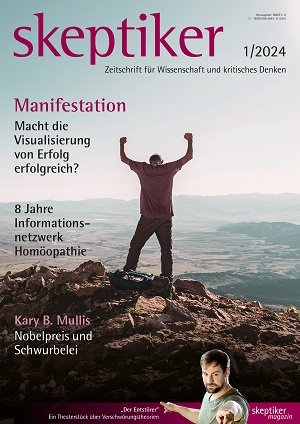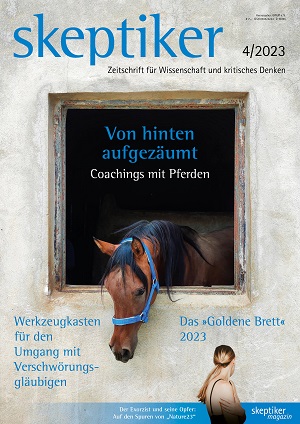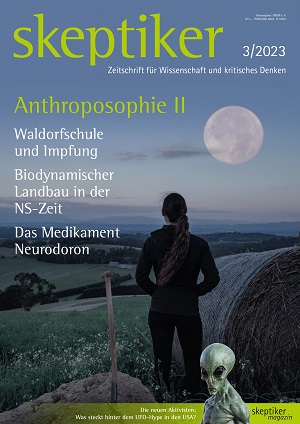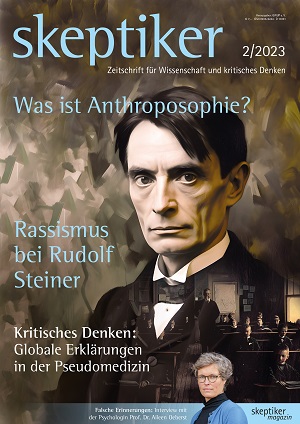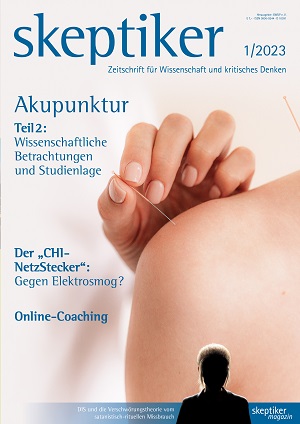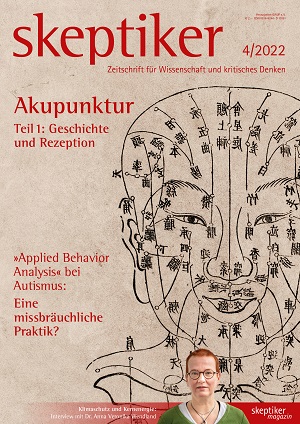Weiterführende Literatur (als PDF) zu
Robert Mestel: Wirkfaktoren in der (Richtlinien-)Psychotherapie. Wie viel unspezifische Faktoren, abergläubische Rituale oder Placebo steckt da drin?
Teil 2, Skeptiker 1/2015
Ahn, H. & Wampold, BE (2001). Where oh where are the specific ingredients? A meta-analysis of component studies in counseling and psychotherapy. Journal of Counseling Psychology 48 (3), 251-257.
Altman DG, Schulz KF, Moher D, Egger M, Davidoff F, Elbourne D, Gøtzsche PC, Lang T; CONSORT GROUP (Consolidated Standards of Reporting Trials). (2001). The revised CONSORT statement for reporting randomized trials: explanation and elaboration. Ann Intern Med., 17, 134 (8):663-94.
Asnaani, A & Foa, EB (2014). Expanding the lens of evidence-based practice in psychotherapy to include a common factors perspective: Comment on Laska, Gurman, and Wampold. Psychotherapy, Vol 51 (4), 487-490.
Baardseth TP, Goldberg SB, Pace BT, Wislocki AP, Frost ND, Siddiqui JR, Lindemann AM, Kivlighan DM 3rd, Laska KM, Del Re AC, Minami T, Wampold BE. (2013). Cognitive-behavioral therapy versus other therapies: redux. Clin Psychol Rev., 33 (3): 395-405.
Baker TB & McFall RM (2014). The promise of science-based training and application in psychological clinical science. Psychotherapy, 51 (4), 482-6.
Baker, T. B., McFall, R. M., & Shoham, V. (2009). Current status and future prospects of clinical psychology: Toward a scientifically principled approach to mental and behavioral health care. Psychological Science in the public Interest, 9 (2), 67-103.
Baldwin, SA & Imel, ZE (2013). Therapist Effects. In M.J. Lambert (Ed.), Bergin and Garfield's Handbook of Psychotherapy and Behavior (6th ed) (p.258-297). New York: John Wiley & Sons.
Bambling, M., King, R., Raue, P., Schweitzer, R. & Lambert, W. (2006). Clinical supervision: Its influence on client-rated working alliance and client symptom reduction in the brief treatment of major depression. Psychotherapy Research, 16 (3), 317-331.
Bamelis LL, Evers SM, Spinhoven P, Arntz A. (2014). Results of a multicenter randomized controlled trial of the clinical effectiveness of schema therapy for personality disorders. Am J Psychiatry, 171(3):305-22.
Barber, J.P., Gallop, R., Crits-Christoph, P., Frank, A., Thase, M.E., Weiss, R.D. & Connolly Gibbons, M.B. (2006), The role of therapist adherence, therapist competence, and the alliance in predicting outcome of individual drug counseling: Results from the NIDA Collaborative Cocaine Treatment Study. Psychotherapy Research, 16(2), 229-240.
Bell EC, Marcus DK, Goodlad JK. (2013). Are the parts as good as the whole? A meta-analysis of component treatment studies. J Consult Clin Psychol., 81 (4): 722-36.
Berger, T. (2014). Internetbasierte Interventionen bei psychischen Störungen. Reihe Fortschritte der Psychotherapie. Göttingen: Hogrefe.
Berman, JS & Norton, NC (1985). Does professional training make a therapist more effective? Psychological Bulletin, Vol 98(2), 401-407.
Beutler, L. E., & Harwood, T. M. (2000). Prescriptive psychotherapy: A practical guide to systematic treatment selection. New York: Oxford University Press.
Beutler, LE (2004). The Empirically Supported Treatments Movement: A Scientist-Practitioner's Response. Clinical Psychology: Science and Practice, 11 (3), 225-229.
Beutler, LE (2014). Welcome to the party, but... Psychotherapy, Vol 51 (4), 496-499.
Beutler, LE, Malik, M., Alimohamed, S., Harwood, TM, Talebi, H., Noble, S. & Wong, E. (2004). Therapist Variables. In MJ Lambert (Ed.): Bergin and Garfield's Handbook of Psychotherapy and Behavior (p. 227-306). New York: John Wiley.
Blais, MA, Jacobo, MC & Smith, SR. (2010). Exploring therapeutic alliance in brief inpatient psychotherapy: a preliminary study. Clin Psychol Psychother., 17(5):386-94.
Bohart, A.C. & Wade, A.G. (2013). The Client in Psychotherapy. In Lambert, M. J.: Bergin and Garfield's Handbook of Psychotherapy and Behavior Change (6th ed., 219-257). New York: John Wiley.
Bohus, M. (2014). Wirkfaktor therapeutische Beziehung – wie ist die Datenlage? Vortrag auf DGPPN-Kongress am 28.11.2014 in Berlin.
Bordin, ES (1979). The generalizability of the psychoanalytic concept of the working alliance. Psychotherapy: Theory, Research & Practice, Vol 16(3), 252-260.
Burlingame, G.M., Strauss, B., Joyce, A.S. Change Mechanisms and Effectiveness of Small Group Treatments. (2013). In MJ Lambert (Ed.): Bergin and Garfield´s Handbook of Psychotherapy and Behavior Change (6th Ed.) (640-689). New York, Wiley.
Burlingame, GM. & Barlow, SH. (1996). Outcome and process differences between professional and nonprofessional therapists in time-limited group psychotherapy. International Journal of Group Psychotherapy, 46 (4), 455-478.
Burns, LR & Wholey, DR (1991). The Effects of Patient, Hospital, and Physician Characteristics on Length of Stay and Mortality. Medical Care, 29, 251-271.
Chambless, DL & Hollon, SD (1998). Defining empirically supported therapies. J Consult Clin Psychol.,66(1):7-18.
Chow, D. (2014). The study of supershrinks: Development and deliberate practices of highly effective psychotherapists. Doctor Thesis Curtin University.
Cohen, J. (1988): Statistical Power Analysis for the Behavioral Sciences, 2. Aufl., Hillsdale: Lawrence Erlbaum Associates
Cooper, M. (2008). Essential Research Findings in Counselling and Psychotherapy: The Facts are Friendly. London: Sage.
Crits-Christoph, P, Gibbons, MBC, Crits-Christoph, K., Narducci, J., Schamberger, M. & Galopp, R. (2006). Can therapists be trained to improve their alliances? A preliminary study of alliance-fostering psychotherapy. Psychotherapy Research, 16 (3), 268-281.
Crits-Christoph, P., Gibbons, MBC & Mukherjee, D. (2013). Psychotherapy Process-Outcome Research. In Lambert, M. J.: Bergin and Garfield's Handbook of Psychotherapy and Behavior Change (6th ed., 298-340). New York: John Wiley.
DeRubeis, RJ, Gelfand, LA, German, RE, Forunier, JC, Forand, NR (2014). Understanding processes of change: How some patients reveal more than others – and some groups of therapists less – about what matters in psychotherapy. Psychother Res. 2014; 24 (3): 419–428.
Dinger U, Strack M, Leichsenring F, Wilmers F, Schauenburg H. Therapist effects on outcome and alliance in inpatient psychotherapy. J Clin Psychol. 2008;64(3):344-354.
Durlak, J. A. (1979). Comparative Effectiveness of Paraprofessional and Professional Helpers. Psychological Bulletin, 86, 80-92.
Durlak, J. A. (1981). Evaluating Comparative Studies of Paraprofessional and Professional Helpers: A Reply to Nietzel and Fisher. Psychological Bulletin, 89, 566-569.
Elliott, R., Greenberg LS, Watson, J., Timulak, L. & Freire, E. (2013). Research on humanistic-experiential psychotherapies. In Lambert, M. J.: Bergin and Garfield's Handbook of Psychotherapy and Behavior Change (6th ed., 495-538). New York: John Wiley.
Emmelkamp PM, David D, Beckers T, Muris P, Cuijpers P, Lutz W, Andersson G, Araya R, Banos Rivera RM, Barkham M, Berking M, Berger T, Botella C, Carlbring P, Colom F, Essau C, Hermans D, Hofmann SG, Knappe S, Ollendick TH, Raes F, Rief W, Riper H, Van Der Oord S, Vervliet B. (2014). Advancing psychotherapy and evidence-based psychological interventions, Int J Methods Psychiatr Res, 23 Suppl 1:58-91.
Engelhard, IM (2012). Making science work in mental health care. Eur J Psychotraumatol. 2012; 3: doi: 10.3402/ejpt.v3i0.18740.
Eschenröder, CT (2014). Wie wirksam sind Techniken der Energetischen Psychotherapie, die Exposition mit sensorischer Stimulierung verbinden? Psychotherapeutenjournal, 2, 149-156.
Farin, E., Jäckel, W.H. & Widera, T. (2009). Prädiktoren der Patientenzufriedenheit in der Rehabilitandenbefragung der Deutschen Rentenversicherung. DRV-Schriften Band 83, 146-148.
Fiedler, P. (2010). Verhaltenstherapie mon amour: Mythos - Fiktion – Wirklichkeit. Stuttgart: Schattauer.
Flückiger C, Del Re AC, Wampold BE, Symonds D, Horvath AO. (2012). How central is the alliance in psychotherapy? A multilevel longitudinal meta-analysis. J Couns Psychol., 59 (1):10-7.
Frank, J. D. & Frank, J. B. (1991). Persuasion and healing: A comparative study of psychotherapy (3rd ed.). Baltimore, MD: Johns Hopkins University.
Garb, HN & Boyle, PA (2015). Understanding why some clinicians use pseudoscientific methods. Findings from research on clinical judgement. In SO Lilienfeld, SJ Lynn & JM Lohr (eds): Science and Pseudoscience in Clinical Psychology (p. 19-41). New York: Guilford Press.
Gaudiano, BA, Dalrymple, KL, Weinstock, LM & Lohr, JM (2015). The Science of Psychotherapy, developing, testing and promoting evidence-based treatments. In Lilienfeld, SO, Lynn, SJ & Lohr JM (eds.):Science and Pseudoscience in clinical psychology (p. 155-190). New York: Guilford Press.
Gelso, CJ & Carter, JA (1985). The Relationship in Counseling and Psychotherapy. The Counseling Psychologist, 13 (2), 155-243.
Giesen-Bloo, J., Dyck van, R., Spinhoven, P., Tilburg van, W., Dirksen, C., Asselt van, T., Kremers, I., Nadort, M., & Arntz, A. (2006). Outpatient psychotherapy for Borderline Personality Disorder: a randomized controlled trial of schema-focused therapy versus transference focused psychotherapy. Archives of General Psychiatry, 63, 649-658.
Grawe, K., Donati, R. & Bernauer, F. (1994). Psychotherapie im Wandel: Von der Konfession zur Profession. Göttingen: Hogrefe.
Gunzelmann, T., Schiepek, G. & Reinecker, H. (1987). Laienhelfer in der psychosozialen Versorgung: Meta-Analysen zur differentiellen Effektivität von Laien und professionellen Helfern. Gruppendynamik, 18 (4), 361-384.
Hattie, JA, Sharpley, CF & Rogers, HJ. (1984). Comparative effectiveness of professional and paraprofessional helpers. Psychological Bulletin, Vol 95 (3),534-541.
Henry, W.P., Schacht, T.E., Strupp, H.H. (1986): Structural analysis of social behavior: Application to a study of interpersonal process of differential psychotherapeutic outcome. Journal of Consulting and Clinical Psychology, 54, 27-31.
Henry, W.P., Strupp, H.H., Butler, S.F., Schacht, T.E., & Binder, J.L. (1993). Effects of training in time-limited dynamic psychotherapy: Changes in therapist behavior. Journal of Consulting and Clinical Psychology, 61:3, 434-440.
Herr, L., Mingebach, T., Becker, K., Christiansen, H. & Kamp-Becker, I. (2015). Wirksamkeit elternzentrierter Interventionen bei Kindern im Alter von zwei bis zwölf Jahren. Kindheit und Entwicklung, 24, 6-19.
Hill CE & Knox, S. (2013). Training and supervision in psychotherapy. In Lambert, M. J.: Bergin and Garfield's Handbook of Psychotherapy and Behavior Change (6th ed., 775-811). New York: John Wiley.
Hofmann, SG, Asnaani, A., Vonk, IJJ, Sawyer, AT & Fang, A. (2012). The Efficacy of Cognitive Behavioral Therapy: A Review of Meta-analyses. Cognit Ther Res.,36 (5): 427–440.
Hofmann, SG.; Barlow, DH. (2014). Evidence-based psychological interventions and the common factors approach: The beginnings of a rapprochement? Psychotherapy, Vol 51 (4), 510-513.
Hoglend, P. (2014). Exploration of the patient-therapist relationship in psychotherapy. Am J Psychiatry., 171 (10): 1056-66.
Howard, K.I., Kopta, S.M., Krause, M.S., & Orlinsky, D.E. (1986). The dose-effect relationship in psychoterahpy. American Psychologist, 41, 159-164.
Huber, D, Zimmermann, J., Henrich, G. & Klug, G. (2012). Comparison of cognitive-behaviour therapy with psychoanalytic and psychodynamic therapy for depressed patients – A three-year follow-up study. Zeitschrift für Psychosomatische Medizin und Psychotherapie, 58, 299–316.
Jacobson NS, Dobson KS, Truax PA, Addis ME, Koerner K, Gollan JK, Gortner E, Prince SE. (1996). A component analysis of cognitive-behavioral treatment for depression. J Consult Clin Psychol., 64 (2): 295-304.
Jung, K. & Steil, R. (2013). A Randomized Controlled Trial on Cognitive Restructuring and Imagery Modification to Reduce the Feeling of Being Contaminated in Adult Survivors of Childhood Sexual Abuse Suffering from PTSD. Psychotherapy and Psychosomatics, 82(4):213-20.
Kazdin, AE (2007). Mediators and mechanisms of change in psychotherapy research. Annu Rev Clin Psychol, 3:1-27.
Kiesewetter, K. & Kiesewetter C. (2010). Franz Anton Mesmers Leben und Lehre: mit einer Vorgeschichte des Mesmerismus, Hypnotismus und Somnambulismus. Leipzig: Bohmeier.
Kindt, H. & Berger, M. (2009). Selbsterfahrung – essenziell oder verzichtbar? Neurotransmitter, 3, 12-14.
Knaevelsrud C, Maercker A. (2007). Internet-based treatment for PTSD reduces distress and facilitates the development of a strong therapeutic alliance: a randomized controlled clinical trial. BMC Psychiatry, 19, 7:13.
Kraus, DR, Castonguay, L., Boswell, JF, Nordberg, SS & Hayes, JA (2011). Therapist effectiveness: Implications for accountability and patient care. Psychotherapy Research, 21(3): 267-276.
Kröner-Herwig, B. (2004). Die Wirksamkeit von Verhaltenstherapie bei psychischen Störungen von Erwachsenen sowie Kindern und Jugendlichen. Expertise zur empirischen Evidenz des Psychotherapieverfahrens Verhaltenstherapie. Tübingen: DGVT-Verlag.
Kyrouz EM, Humphreys K & Loomis C. A review on research on the effectiveness of self-help mutual aid groups. In: White BJ & Madara, EJ (eds.) The Self-help Group Sourcebook (7. ed. p. 71-82). Denville, NJ: American Self-Help Clearinghouse.
Laireiter, AR (2000) (Hrsg.). Selbsterfahrung in Psychotherapie und Verhaltenstherapie: Empirische Befunde Sondereinband. Tübingen: DGVT-Verlag.
Laireiter, A. (2009). Zur funktionalen Äquivalenz von Sozialer Unterstützung und Psychotherapie. In Röhrle, B. & Laireiter, A.R. (Hrsg.) Soziale Unterstützung und Psychotherapie (S. 123-225). Tübingen: DGVT-Verlag.
Laireiter, A-R. (2014). Selbsterfahrung in der Psychotherapie. Die Ergebnislage. In SB Gahleitner, R. Reichel, B. Schigl & A. Leitner (Hrsg.): Wann sind wir gut genug? Selbstreflexion, Selbsterfahrung und Selbstsorge in Psychotherapie, Beratung und Supervision (S. 74-90). Weinheim: Beltz.
Lampe, A., Mitmansgruber, H., Gast, U., Schüssler, G. & Reddemann, L. (2008). Therapieevaluation der Psychodynamisch Imaginativen Traumatherapie (PITT) im stationären Setting. Neuropsychiatrie, 22, 3, 189-197.
Laska KM, Gurman AS, Wampold BE. (2014). Expanding the lens of evidence-based practice in psychotherapy: a common factors perspective. Psychotherapy (Chic),51 (4): 467-81.
Leichsenring F, Salzer S, Beutel ME, Herpertz S, Hiller W, Hoyer J, Huesing J, Joraschky P, Nolting B, Poehlmann K, Ritter V, Stangier U, Strauss B, Tefikow S, Teismann T, Willutzki U, Wiltink J, Leibing E. (2014). Long-term outcome of psychodynamic therapy and cognitive-behavioral therapy in social anxiety disorder. Am J Psychiatry, 171 (10): 1074-82.
Leon, SC, Martinovich, Z., Lutz, W. & Lyons, JS (2005). The effect of therapist experience on psychotherapy outcomes. Clinical Psychology & Psychotherapy, Volume 12 (6), 417–426.
Liebherz, S, Rabung, S (2013) Wirksamkeit psychotherapeutischer Krankenhausbehandlung im deutschsprachigen Raum: Eine Meta-Analyse Psychotherapie, Psychosomatik, medizinische Psychologie, 63, 355-364.
Liebherz, S. & Rabung, S. (2015). Do Patients' Symptoms and Interpersonal Problems Improve in Psychotherapeutic Hospital Treatment in Germany? - A Systematic Review and Meta-Analysis. PLOS One, DOI: 10.1371/journal.pone.0105329
Lilienfeld SO, Ritschel LA, Lynn SJ, Cautin RL, Latzman RD. (2013). Why many clinical psychologists are resistant to evidence-based practice: root causes and constructive remedies. Clin Psychol Rev.,33(7): 883-900.
Lilienfeld, S. O. (2007). Psychological treatments that cause harm. Perspectives on Psychological Science, 2, 53–70.
Lilienfeld, SO, Lynn, SJ & Lohr JM (eds.) (2015). Science and Pseudoscience in Clinical Psychology. New York: Guilford Press.
Linden, M. & Strauss, B. (2012). Risiken und Nebenwirkungen von Psychotherapie: Erfassung, Bewältigung, Risikovermeidung. Berlin: MWV Medizinisch Wissenschaftliche Verlagsgesellschaft.
Lohr, JM, Gist, R., Deacon, B., Devilly, GJ & Varker, T. (2015). Science- and Non-Science-Based Treatments for Trauma-Related Stress Disorders. In SO Lilienfeld, SJ Lynn & JM Lohr (eds): Science and Pseudoscience in Clinical Psychology (p. 277-321). New York: Guilford Press.
Lüdtke, R. (2006). Statistischer Kommentar zur Publikation von Prof. Diener. Deutsche Zeitschrift für Akupunktur, 49, 2, 42-43.
Marcus DK, O'Connell D, Norris AL, Sawaqdeh A. (2014). Is the Dodo bird endangered in the 21st century? A meta-analysis of treatment comparison studies. Clin Psychol Rev., 34 (7): 519-30.
Margraf, J. (2009). Kosten und Nutzen der Psychotherapie. Eine kritische Literaturauswertung. Heidelberg: Springer Medizinverlag.
McHugh RK, Whitton SW, Peckham AD, Welge JA, Otto MW. (2013). Patient preference for psychological vs pharmacologic treatment of psychiatric disorders: a meta-analytic review. J Clin Psychiatry,74(6): 595-602.
McKay KM1, Imel ZE, Wampold BE. (2006). Psychiatrist effects in the psychopharmacological treatment of depression. J Affect Disord., 92 (2-3): 287-90.
Mehrabi, F. (2012). Der Zusammenhang von Bindung, therapeutischer Allianz und Therapieerfolg bei der Therapie von Sozialer Phobie:Ein Vergleich zwischen kognitiver Verhaltenstherapie und psychodynamischer Kurzzeittherapie. Unveröffentlichte Diplomarbeit: Universität Jena.
Mendel R, Hamann J, Traut-Mattausch E, Bühner M, Kissling W, Frey D. (2010). 'What would you do if you were me, doctor?': randomised trial of psychiatrists' personal v. professional perspectives on treatment recommendations. Br J Psychiatry.,197(6):441-7.
Mergl R, Henkel V, Allgaier AK, Kramer D, Hautzinger M, Kohnen R, Coyne J & Hegerl U. (2009). Are treatment preferences relevant in response to serotonergic antidepressants and cognitive-behavioral therapy in depressed primary care patients? Results from a randomized controlled trial including a patients' choice arm. Psychother Psychosom,80(1):39-47.
Mestel, R. (2014). Wirkfaktoren in der (Richtlinien-) Psychotherapie. Teil 1. Skeptiker, 4, 4-15.
Mestel, R. (2015). Zusammenhänge zwischen Therapiedauer und stationärem Therapieerfolg (GSI-Differenz) bei allen Akut- und Rehapatienten der HELIOS Klinik Bad Grönenbach von 1993-2013 mit vollständigen prä und post Datensätzen. Unveröffentlichtes Arbeitspapier.
Mestel, R., Erdmann, A., Schmid, M., Klingelhöfer, J., Stauss, K. & Hautzinger, M. (2000a). 1-3 Jahres Katamnese bei 800 stationär behandelten depressiven Patienten. In Bassler, M. (Hrsg.): Leitlinien zur stationären Psychotherapie: Pro und Kontra (S. 243 - 273). Gießen: Psychosozial Verlag.
Mestel, R., Stalder, K., von Wahlert, J. & Hautzinger, M. (2012). Frühes Ansprechen auf stationäre psychosomatische Rehabilitation als Prädiktor bei depressiven Patienten. Poster mit Vortrag auf dem DKPM/DGPM Kongress 2012 in München am 30.3.2012.
Mestel, R., Vogler, J. & Klingelhöfer, J. (2002). Katamnesen mit AngstpatientInnen nach psychodynamischer verglichen mit kombiniert psychodynamisch-verhaltenstherapeutischer stationärer Psychotherapie. In Bassler, M. (Hrsg.): Stationäre Gruppenpsychotherapie (S. 50 – 97). Psychosozial Verlag: Gießen.
Mestel, R., Neeb, K., Hauke, B., Klingelhöfer, J. & Stauss, K. (2000b). Zusammenhänge zwischen der Therapiezeitverkürzung und dem Therapieerfolg bei depressiven Patienten. In Bassler, M. (Hrsg.): Wirkfaktoren von stationärer Psychotherapie (S. 98 - 146). Gießen: Psychosozial Verlag.
Miller, S., Wampold, BE & Varhely, K. (2008). Direct comparisons of treatment modalities for youth disorders: a meta-analysis. Psychotherapy Research, 18:1, 5 – 14.
Miller, SD, Hubble, MA, Chow, DL & Seidel, JA. (2013). The outcome of psychotherapy: Yesterday, today, and tomorrow. Psychotherapy, 50 (1), 88-97.
Munder T, Brütsch O, Leonhart R, Gerger H, Barth J. (2014). Researcher allegiance in psychotherapy outcome research: an overview of reviews. Clin Psychol Rev.,33 (4), 501-11.
Neuner, F. (2008). Stabilisierung vor Konfrontation in der Traumatherapie-Grundregel oder Mythos? Verhaltenstherapie, 18, 109-118.
Norcross JC & Lambert, MJ (2011b). Evidence-based therapy relationships. In Norcross JC (ed.). Relationships that work (2nd ed). Oxford: Oxford University Press.
Norcross JC (ed.). (2011). Relationships that work (2nd ed). Oxford: Oxford University Press.
Norcross JC, Lambert MJ. (2011a). Psychotherapy relationships that work II.Psychotherapy, 48(1): 4-8.
Norcross, JC.; Wampold, BE. (2011). Evidence-based therapy relationships: Research conclusions and clinical practices. Psychotherapy, Vol 48(1), 98-102.
Ogles, BM (2013). Measuring Change in Psychotherapy Research. In M.J. Lambert (Ed.), Bergin and Garfield's Handbook of Psychotherapy and Behavior (6th ed) (p.134-166). New York: John Wiley & Sons.
Orlinsky, D.E., Grawe, K. & Parks, B.K. (1994). Process and Outcome in psychotherpy - noch einmal. In A.E. Bergin & S.L. Garfield (eds.), Handbook of Psychotherapy and Behavior Change (4the ed). New York: John Wiley & Sons. 270-378.
Oster, J., Müller, G. & von Wietersheim, J. (2009). "Wer profitiert?" - Patientenmerkmale als Erfolgsprädiktoren in der psychosomatischen Rehabilitation. Die Rehabilitation, 48, 95-102.
Pignotti, M. & Thyer, BA (2015). New Age and related novel unsupported therapies in mental health practice. In SO Lilienfeld, SJ Lynn & JM Lohr (eds): Science and Pseudoscience in Clinical Psychology (p. 191-209). New York: Guilford Press.
Raue, PJ., Goldfield, MR & Barkham, M. (1997). The Therapeutic Alliance in Psychodynamic-Interpersonal and Cognitive-Behavioral Therapy. Journal of Consulting and Clinical Psychology, 65 (4), 582-587.
Reuter, L., Bengel, J. & Scheidt, CE (2014). Therapie-Non-Response in der psychosomatischen Krankenhausbehandlung und Rehabilitation - Eine systematische Übersicht. Zeitschrift für Psychosomatische Medizin und Psychotherapie, 60 (2), S. 121-145.
Riedel-Heller SG, Matschinger H, Angermeyer MC. (2005). Mental disorders--who and what might help? Help-seeking and treatment preferences of the lay public. Soc Psychiatry Psychiatr Epidemiol.,40 (2):167-74.
Rogers, C. (1981). Der neue Mensch (10. Auflage 2015). Stuttgart: Klett-Cotta.
Röhrle, B. & Laireiter, A.R. (2009) (Hrsg.). Soziale Unterstützung und Psychotherapie. Tübingen: DGVT-Verlag.
Röhrle, B. & Strouse, J. (2008). Influence of social support on success of therapeutic interventions: A Meta-Analytic Review. Psychotherapy, Theory, Research, Practice, Training. 45, (4), 464-476.
Röhrle, B. & Strouse, J. (2009). Der Einfluss sozialer Netzwerke auf den psychotherapeutischen Erfolg - eine Meta-Analyse. In Röhrle, B. & Laireiter, A.R. (Hrsg.) Soziale Unterstützung und Psychotherapie (S. 277-296). Tübingen: DGVT-Verlag.
Rosenzweig, S. (1936). Some implicit common factors in diverse methods of psychotherapy. American Journal of Orthopsychiatry, 6 (3), 412–15.
Roth, A. & Fonagy, P. (2005). What Works for Whom? A Critical Review of Psychotherapy Research (2nd edn). New York: Guilford Press. 2005.
Rounsaville, BJ & Carroll, KM (2002). Commentary on Dodo Bird Revisited: Why Aren't We Dodos Yet? Clinical Psychology: Science and Practice, 9 (1), 17-20
Safran, J.D., Muran, J.C., & Eubanks-Carter, C. (2011). Repairing alliance ruptures. Psychotherapy, 48:1, 80-87.
Sartory, G . (2009) . Macht Selbsterfahrung bessere Psychotherapeuten? Verhaltenstherapie, 19, 53-55 .
Saxon D, Barkham M. (2012). Patterns of therapist variability: therapist effects and the contribution of patient severity and risk. J Consult Clin Psychol.,80 (4):535-46.
Schauer, M. & Ruf-Leuschner, M. (2014). Lifeline in der Narrativen Expositionstherapie. Psychotherapeut, 59(3), 226-238.
Schubbe, O. (2014). EMDR, Brainspotting und Somatic Experiencing in der Behandlung von Traumafolgestörungen. Psychotherapeutenjournal, 2, 156-163.
Siev, J, Huppert, J, & Chambless, DL (2009). The Dodo Bird, treatment technique, and disseminating empirically supported treatments. The Behavior Therapist, 32 (4), 69, 71-76.
Sloane, R. B. , Staples, F. R. , Cristol, A. H. , Yorkston, N. J. & Whipple, K. (1975). Short-term analytically oriented psychotherapy versus behaviour therapy. American Journal of Psychiatry, 132 (4), 373-377.
Smith-Hansen L, Constantino MJ, Piselli A, Remen AL. (2011). Preliminary results of a video-assisted psychotherapist workshop in alliance strategies. Psychotherapy, 48(2):148-62.
Spielmans GI, Pasek LF & McFall JP. (2007). What are the active ingredients in cognitive and behavioral psychotherapy for anxious and depressed children? A meta-analytic review. Clin Psychol Rev. 27(5): 642-54.
Steffanowski, A., Löschmann, C., Schmidt, J., Wittmann, W. W. & Nübling, R. (2007). Metaanalyse der Effekte psychosomatischer Rehabilitation. Bern, Huber.
Stein, DM & Lambert MJ (1995). Graduate training in psychotherapy: are therapy outcomes enhanced?J Consult Clin Psychol.;63(2):182-96.
Strauss, B., Barnow, S., Brähler, E., Fegert, J., Fliegel, S., Freyberger, HJ., Goldbeck, L., Leuzinger-Bohleber, M. & Willutzki, U. und andere (2009). Forschungsgutachten zur Ausbildung von Psychologischen Psychotherapeuten und Ki./Ju. Psychotherapeuten. www.bundesgesundheitsministerium.de/ fileadmin/redaktion/pdf_publikationen/Ausbildung-Psychologische-Psychotherapeuten_200905.pdf
Strupp, H. H. & Hadley, S. W. (1979). Specific vs Non specific Factors in Psychotherapy. Archives of General Psychiatry, 36, 1125-1136.
Tolin DF (2010). Is cognitive-behavioral therapy more effective than other therapies? A meta-analytic review. Clin Psychol Rev., 30 (6): 710-20.
Tracey TJ, Wampold BE, Lichtenberg JW & Goodyear RK. (2014). Expertise in psychotherapy: an elusive goal? Am Psychol.,69(3):218-29.
Tschuschke V, Crameri A, Koehler M, Berglar J, Muth K, Staczan P, Von Wyl A, Schulthess P, Koemeda-Lutz M. (2014). The role of therapists' treatment adherence, professional experience, therapeutic alliance, and clients' severity of psychological problems: Prediction of treatment outcome in eight different psychotherapy approaches. Preliminary results of a naturalistic study. Psychother Res., 4, DOI: 10.1080/10503307.2014.896055
Von Spinn, C., Laireiter, A.R. & Sauer, J. (2009). Die Begleiter von Psychotherapie: Soziales Netzwerk und professionelle und paraprofessionelle Helfer. Eine explorative Studie. In Röhrle, B. & Laireiter, A.R. (Hrsg.) Soziale Unterstützung und Psychotherapie (S. 397-418). Tübingen: DGVT-Verlag.
von Sydow, K. (2014). Psychotherapeuten und ihre psychischen Probleme. Forschungsstand zu einem Klischee. Psychotherapeut, 59(4), 283-292.
Walfish S, McAlister B, O'Donnell P, Lambert MJ. (2012). An investigation of self-assessment bias in mental health providers. Psychol Rep., 110(2): 639-44.
Wampold, B. E., & Brown, G. S. (2005). Estimating therapist variability: A naturalistic study of outcomes in managed care. Journal of Consulting and Clinical Psychology, 73, 914-923.
Wampold, B. E., Mondin, G. W., Moody, M., Stich, F., Benson, K., & Ahn, H. (1997). A meta-analysis of outcome studies comparing bona fide psychotherapies: Empiricially, "all must have prizes.". Psychological Bulletin, 122(3), 203-215.
Wampold, BE & Imel, ZE (2015). The great psychotherapy debate (2nd ed.).
Wampold, BE (2001). The great psychotherapy debate. New York: Lawrence Erlbaum.
Wampold, BE (2012). Humanism as common factor in psychotherapy. Psychotherapy, 49 (4), 445–449.
Watts BV, Schnurr PP, Mayo L, Young-Xu Y, Weeks WB, Friedman MJ (2013). Meta-analysis of the efficacy of treatments for posttraumatic stress disorder. The Journal of Clinical Psychiatry, 74(6):e541-50]
Webb CA, Derubeis RJ, Barber JP. (2010). Therapist adherence/competence and treatment outcome: A meta-analytic review. J Consult Clin Psychol., 78 (2): 200-11.
Weisz JR, Chorpita BF, Palinkas LA, Schoenwald SK, Miranda J, Bearman SK, Daleiden EL, Ugueto AM, Ho A, Martin J, Gray J, Alleyne A, Langer DA, Southam-Gerow MA, Gibbons RD; Research Network on Youth Mental Health. (2012). Testing standard and modular designs for psychotherapy treating depression, anxiety, and conduct problems in youth: a randomized effectiveness trial. Arch Gen Psychiatry, 69 (3): 274-82.
Weisz JR, Weiss B, Han SS, Granger DA, Morton T. (1995). Effects of psychotherapy with children and adolescents revisited: a meta-analysis of treatment outcome studies. Psychol Bull., 117(3):450-68.
Willutzki U, Reinke-Kappenstein B & Hermer, M: Ohne Heiler geht es nicht. Bedeutung von Psychotherapeuten für Therapieprozess und -ergebnis. Psychotherapeut 2013; 58 (5): 427–37.
Wittmann, W. W. & Matt, G. E. (1986). Meta-Analyse als Integration von Forschungsergebnissen am Beispiel deutschsprachiger Arbeiten zur Effektivität von Psychotherapie. Psychologische Rundschau, 37, 20-40.
Zimmermann J, Löffler-Stastka H, Huber D, Klug G, Alhabbo S, Bock A, Benecke C. (2014). Is It All about the Higher Dose? Why Psychoanalytic Therapy Is an Effective Treatment for Major Depression. Clin Psychol Psychother., 4, doi: 10.1002/cpp.1917.





